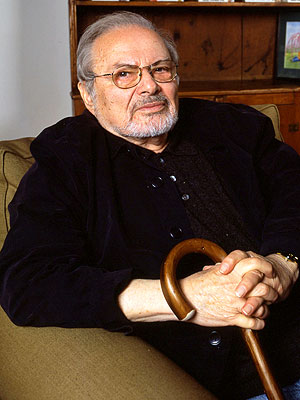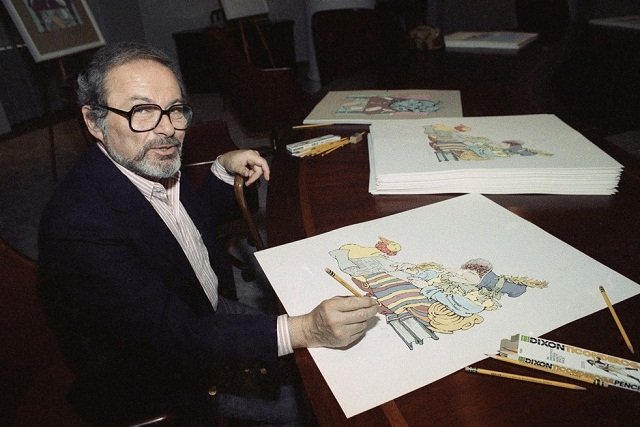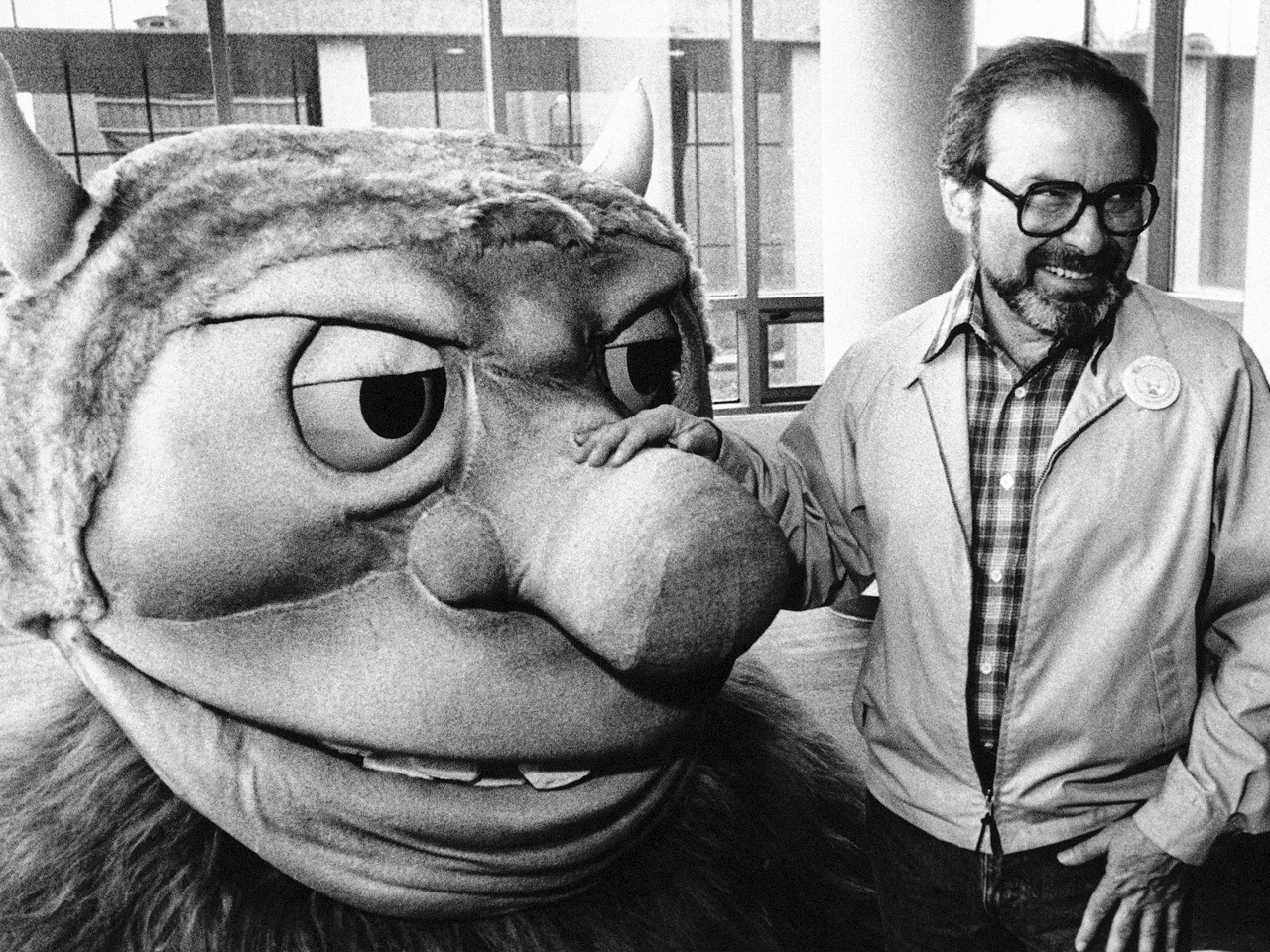Maurice Sendak (Maurice Sendak)

Sendak was born in New York City in the borough of Brooklyn to Polish Jewish immigrant parents named Sadie (née Schindler) and Philip Sendak, a dressmaker. Sendak described his childhood as a “terrible situation” due to the death of members of his extended family during the Holocaust which exposed him at a young age to the concept of mortality. His love of books began when, as a child, he developed health problems and was confined to his bed. He decided to become an illustrator after watching Walt Disney’s film Fantasia at the age of twelve. One of his first professional commissions was to create window displays for the toy store F.A.O. Schwarz. His illustrations were first published in 1947 in a textbook titled Atomics for the Millions by Dr. Maxwell Leigh Eidinoff. He spent much of the 1950s illustrating children’s books written by others before beginning to write his own stories.
His older brother Jack Sendak also became an author of children’s books, two of which were illustrated by Maurice in the 1950s. Maurice was the youngest of three siblings. His sister, Natalie, was nine years older than he, and his brother, Jack, was five years older than he.
Sendak gained international acclaim after writing and illustrating Where the Wild Things Are, edited by Ursula Nordstrom at Harper & Row. It features Max, a boy who “rages against his mother for being sent to bed without any supper”. The book’s depictions of fanged monsters concerned some parents when it was first published, as his characters were somewhat grotesque in appearance. Before Where the Wild Things Are, Sendak was best known for illustrating Else Holmelund Minarik’s Little Bear series of books.
Sendak later recounted the reaction of a fan: A little boy sent me a charming card with a little drawing on it. I loved it. I answer all my children’s letters – sometimes very hastily – but this one I lingered over. I sent him a card and I drew a picture of a Wild Thing on it. I wrote, ‘Dear Jim: I loved your card.’ Then I got a letter back from his mother and she said: ‘Jim loved your card so much he ate it.’ That to me was one of the highest compliments I’ve ever received. He didn’t care that it was an original Maurice Sendak drawing or anything. He saw it, he loved it, he ate it.
Almost fifty years later, School Library Journal sponsored a survey of readers which identified Where the Wild Things Are as top picture book. The librarian who conducted it observed that there was little doubt what would be voted number one and highlighted its designation by one reader as a watershed, “ushering in the modern age of picture books”. Another called it “perfectly crafted, perfectly illustrated … simply the epitome of a picture book” and noted that Sendak “rises above the rest in part because he is subversive”.
When Sendak saw a manuscript of Zlateh the Goat and Other Stories, the first children’s book by Isaac Bashevis Singer, on the desk of an editor at Harper & Row, he offered to illustrate the book. It was first published in 1966 and received a Newbery Honor. Sendak was delighted and enthusiastic about the collaboration. He once wryly remarked that his parents were “finally” impressed by their youngest child when he collaborated with Singer.
His book In the Night Kitchen, originally issued in 1970, has often been subjected to censorship for its drawings of a young boy prancing naked through the story. The book has been challenged in several American states including Illinois, New Jersey, Minnesota, and Texas. In the Night Kitchen regularly appears on the American Library Association’s list of “frequently challenged and banned books”. It was listed number 21 on the “100 Most Frequently Challenged Books of 1990–1999”.
His 1981 book Outside Over There is the story of a girl, Ida, and her sibling jealousy and responsibility. Her father is away and so Ida is left to watch her baby sister, much to her dismay. Her sister is kidnapped by goblins and Ida must go off on a magical adventure to rescue her. At first, she is not really eager to get her sister and nearly passes her sister right by when she becomes absorbed in the magic of the quest. In the end, she rescues her baby sister, destroys the goblins, and returns home committed to caring for her sister until her father returns home.
Sendak was an early member of the National Board of Advisors of the Children’s Television Workshop during the development stages of the Sesame Street television series. He also adapted his book Bumble Ardy into an animated sequence for the series, with Jim Henson as the voice of Bumble Ardy. He wrote and designed three other animated stories for the series: “Seven Monsters” (which never aired), “Up & Down”, and “Broom Adventures”.
Sendak produced an animated television production based on his work titled Really Rosie, featuring the voice of Carole King, which was broadcast in 1975 and is available on video (usually as part of video compilations of his work). An album of the songs was also produced. He contributed the opening segment to Simple Gifts, a Christmas collection of six animated shorts shown on PBS TV in 1977 and later issued on VHS in 1993. He adapted his book Where the Wild Things Are for the stage in 1979. Additionally, he designed sets for many operas and ballets, including the award-winning (1983) Pacific Northwest Ballet production of Tchaikovsky’s The Nutcracker, Houston Grand Opera’s productions of Mozart’s The Magic Flute (1981) and Humperdinck’s Hansel and Gretel (1997), Los Angeles County Music Center’s 1990 production of Mozart’s Idomeneo, and the New York City Opera’s 1981 production of Janáček’s The Cunning Little Vixen. In the 1990s, Sendak approached playwright Tony Kushner to write a new English version of the Czech composer Hans Krása’s children’s Holocaust opera Brundibár. Kushner wrote the text for Sendak’s illustrated book of the same name, published in 2003. The book was named one of the New York Times Book Review’s 10 Best Illustrated Books of 2003.
In 2003, Chicago Opera Theatre produced Sendak and Kushner’s adaptation of Brundibár. In 2005, Berkeley Repertory Theatre, in collaboration with Yale Repertory Theatre and Broadway’s New Victory Theater, produced a substantially reworked version of the Sendak-Kushner adaptation. In 2004 Sendak worked with the Shirim Klezmer Orchestra in Boston on their project “Pincus and the Pig: A Klezmer Tale”. This Klezmer version of Sergei Prokofiev’s famous musical story for children, Peter and the Wolf featured Maurice Sendak as the narrator. He also illustrated the cover art. Sendak also created the children’s television program Seven Little Monsters.
Sendak died on May 8, 2012, in Danbury, Connecticut, at Danbury Hospital, from complications of a stroke. The New York Times obituary called Sendak “the most important children’s book artist of the 20th century.” Author Neil Gaiman remarked, “He was unique, grumpy, brilliant, gay, wise, magical and made the world better by creating art in it.” Author R. L. Stine called Sendak’s death “a sad day in children’s books and for the world.” “We are all honored to have been briefly invited into his world,” remarked comedian Stephen Colbert.
The 2012 season of Pacific Northwest Ballet’s “The Nutcracker,” for which Sendak designed the set, was dedicated to his memory. His final book, Bumble-Ardy, was published eight months before his death. A posthumous picture book, titled My Brother’s Book, was published in February 2013. The film Her was dedicated in memory of him and Where the Wild Things Are co-star James Gandolfini. The film had been directed by Spike Jonze, who had also directed the motion picture adaptation of Where the Wild Things Are.
Born
- June, 10, 1928
- USA
- Brooklyn, New York
Died
- May, 08, 2012
- USA
- Danbury, Connecticut
Other
- Cremated



